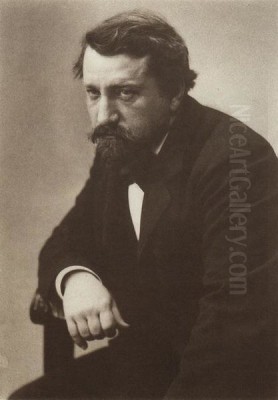
Valentin Alexandrovich Serov stands as a colossus in the landscape of Russian art, a pivotal figure whose career bridged the profound realism of the 19th century with the burgeoning modernist sensibilities of the early 20th. Born in St. Petersburg on January 19, 1865 (January 7, Old Style), and passing away in Moscow on December 5, 1911, Serov's relatively short but intensely productive life yielded a body of work celebrated for its psychological depth, technical brilliance, and stylistic evolution. Primarily renowned as Russia's foremost portraitist of his era, his artistic journey also encompassed landscape, historical painting, graphic arts, and stage design, leaving an indelible mark on the cultural fabric of his time.
An Artistic Cradle: Early Life and Influences
Valentin Serov was born into an environment steeped in artistic creation. His father, Alexander Nikolayevich Serov, was a prominent composer and influential music critic, while his mother, Valentina Semyonovna Serova (née Bergman), was a composer and pianist of note, herself a former student of Anton Rubinstein. This immersion in music and the broader arts from infancy undoubtedly shaped the young Valentin's sensibilities. The Serov household was a hub for intellectuals and artists, exposing the child to a vibrant cultural milieu.
Following his father's death in 1871, Valentin's upbringing continued under his mother's guidance, often involving travel and exposure to different artistic circles. A crucial early encounter occurred when, at the age of nine, his burgeoning talent for drawing caught the attention of the great realist master, Ilya Repin. Repin recognized the boy's potential and began giving him informal lessons, first in Paris and later in Moscow. This early mentorship was foundational, instilling in Serov a deep respect for keen observation and truthful representation.
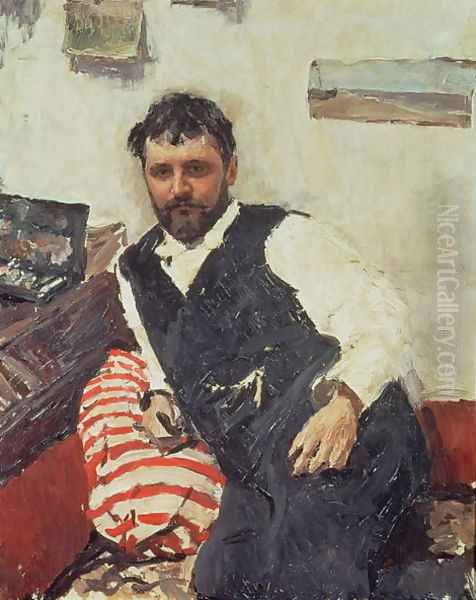
The artistic atmosphere of his youth was further enriched by time spent at Abramtsevo, the estate near Moscow owned by the wealthy industrialist and arts patron Savva Mamontov. Abramtsevo was a vital artistic colony, a gathering place for many leading figures of Russian culture. Here, Serov mingled with painters like Repin, Viktor Vasnetsov, Apollinary Vasnetsov, Vasily Polenov, and his soon-to-be close friend Konstantin Korovin, as well as the uniquely imaginative Mikhail Vrubel. This environment fostered collaboration, experimentation, and a deep connection to Russian landscape and folk traditions.
Formal Training and the Shaping of a Style
Recognizing the need for more structured training, Repin encouraged Serov to enroll in the prestigious Imperial Academy of Arts in St. Petersburg in 1880. There, he became a student of Pavel Chistyakov, a highly respected pedagogue known for his rigorous emphasis on drawing, form, and anatomical accuracy. Chistyakov's systematic approach complemented Repin's more intuitive guidance, providing Serov with a formidable technical grounding. His fellow students at the Academy included Mikhail Vrubel, further cementing connections within the next generation of Russian artists.
Serov's time at the Academy (until 1885) was marked by diligent study, but he also continued to absorb influences from beyond its walls. He traveled, visiting museums in Western Europe, where he encountered the works of Old Masters and, significantly, the burgeoning Impressionist movement. While deeply rooted in the realist tradition championed by Repin and the Peredvizhniki (the Wanderers), Serov was receptive to the Impressionists' exploration of light, color, and capturing fleeting moments.
His early works began to show a synthesis of these influences. He retained the psychological acuity and solid draftsmanship inherited from his Russian mentors but started experimenting with freer brushwork, a brighter palette, and a keen interest in the effects of natural light on form and color. This fusion would soon lead to his first major triumphs.
Breakthrough Masterpieces: Capturing Light and Youth
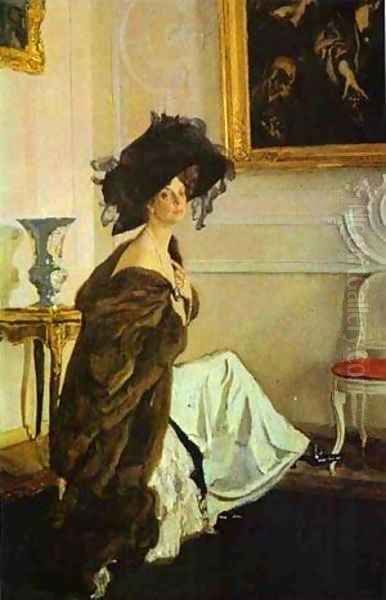
The late 1880s marked Serov's arrival as a major artistic force, heralded by two paintings that remain icons of Russian art. In 1887, while staying at Abramtsevo, he painted the portrait of Savva Mamontov's twelve-year-old daughter, Vera. The resulting work, Girl with Peaches (Portrait of V.S. Mamontova), is a masterpiece of youthful spontaneity and luminous atmosphere. Bathed in the soft, diffused light streaming through a nearby window, Vera sits at a table, a blush on her cheeks, her dark eyes gazing directly yet introspectively at the viewer. The painting masterfully combines precise rendering of the figure with looser, more painterly handling of the background, capturing the textures of fruit, tablecloth, and wood with palpable realism, while the play of light and shadow across the scene evokes a sense of immediacy and vibrant life. It demonstrated Serov's unique ability to blend psychological insight with a fresh, almost impressionistic sensitivity to light and color.
A year later, in 1888, Serov created another landmark painting, Girl in Sunlight (Portrait of M.Ya. Simonovich). This portrait depicts his cousin, Maria Simonovich, seated outdoors on a bench, dappled sunlight filtering through foliage overhead. Here, the influence of Impressionism is even more apparent in the broken brushwork used to render the play of light and shadow across Maria's white blouse and face, and the vibrant greens and yellows of the surrounding garden. Yet, the painting retains a solidity of form and a depth of characterization that distinguishes it from French Impressionism. Serov was not merely capturing a fleeting visual sensation; he was exploring the inner world of his subject within a specific, light-filled moment. These two paintings cemented Serov's reputation as a brilliant young talent capable of revitalizing the genre of portraiture.
The Pinnacle of Portraiture: Psychological Depth and Social Panorama
Following the success of his early works, Serov rapidly became the most sought-after portrait painter in Russia. His sitters comprised a veritable who's who of Russian society at the turn of the century: members of the Imperial family, aristocrats, wealthy industrialists, fellow artists, writers, musicians, and actors. What distinguished Serov's portraits was his uncanny ability to penetrate beyond mere likeness and capture the essential character, psychology, and social standing of his subjects. He possessed a sharp, analytical eye, often revealing complexities and contradictions beneath the surface.
His approach was demanding, often requiring numerous lengthy sittings. He sought not just a physical resemblance but an inner truth, a defining gesture, glance, or posture that encapsulated the individual. His portraits of fellow artists, such as the relaxed, informal depiction of Konstantin Korovin (1891) or the intense, brooding portrayal of the landscape painter Isaac Levitan (1893), reveal a deep understanding born of friendship and shared artistic pursuits.
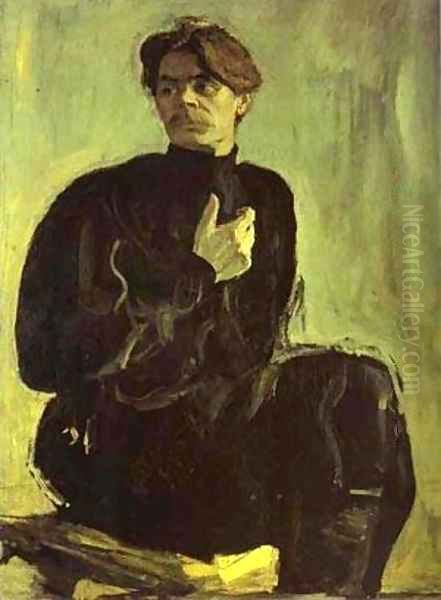
He painted members of the Imperial family, including Tsar Nicholas II himself, often managing to convey a sense of official duty tinged with personal vulnerability or reservation. His portraits of powerful aristocrats, like the elegant and commanding Princess Zinaida Yusupova (1902) or the famously imposing Princess Olga Orlova (1911), are masterclasses in rendering social status through pose, attire, and setting, while still hinting at the personality within the public persona. He captured the intellectual intensity of writers like Maxim Gorky (1905) and the theatrical presence of performers like the great basso Feodor Chaliapin (1905).
Serov adapted his style to suit his subject. Some portraits are characterized by meticulous detail and a relatively smooth finish, while others employ bolder brushwork and a more summary execution, focusing on capturing energy and movement. His palette could range from the subtle, silvery tones favored in some early works to the richer, more complex color harmonies of his mature period. Throughout, his draftsmanship remained impeccable, providing a solid structure even in his most painterly creations.
Navigating Artistic Currents: Peredvizhniki and Mir Iskusstva
Serov's career unfolded during a period of significant artistic debate and shifting allegiances in Russia. He initially associated with the Peredvizhniki (The Wanderers), the dominant realist group founded in the 1870s, officially joining them in 1894. The Peredvizhniki championed socially conscious art, often depicting scenes of everyday life and Russian history with a critical or didactic edge. Serov exhibited with them and shared their commitment to realism, but his artistic interests extended beyond their sometimes narrow focus.
By the late 1890s, a new artistic movement, Mir Iskusstva (World of Art), emerged, challenging the dominance of the Peredvizhniki. Led by figures like Sergei Diaghilev and Alexandre Benois, Mir Iskusstva advocated for aestheticism ("art for art's sake"), a synthesis of different art forms (painting, theatre, music, decorative arts), and a greater openness to contemporary Western European art movements like Symbolism and Art Nouveau, alongside a renewed appreciation for 18th-century Russian art and folk traditions.
Serov found himself increasingly drawn to the broader artistic horizons offered by Mir Iskusstva. While respecting the Peredvizhniki's legacy, he felt constrained by their sometimes rigid ideology and aesthetic criteria. He formally broke with the Wanderers and became a key member of the World of Art group around 1899. This association proved highly fruitful, connecting him with artists like Léon Bakst, Konstantin Somov, and Mstislav Dobuzhinsky, and involving him in the group's influential journal and exhibitions. His involvement with Mir Iskusstva coincided with a further evolution in his style, incorporating more decorative elements and graphic clarity.
Beyond Portraiture: Landscape, History, and Graphics
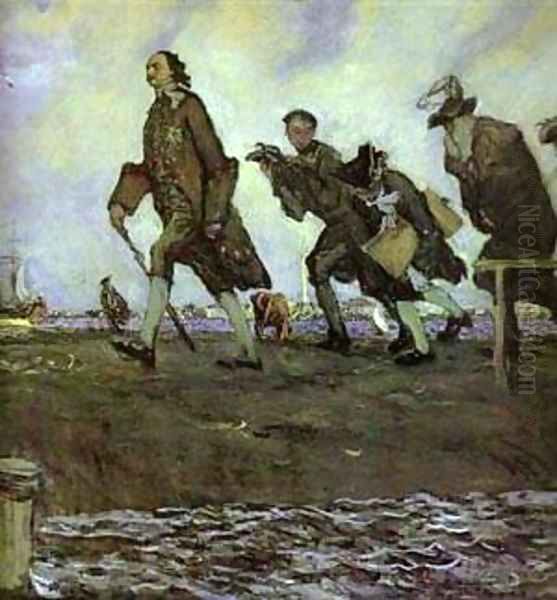
While portraiture remained central to his oeuvre, Serov's artistic talents extended to other genres. His landscapes, often painted during stays at country estates like Domotkanovo (belonging to his friend Vladimir Derviz), possess a lyrical intimacy. Works like October. Domotkanovo (1895) capture the specific moods and light of the Russian countryside with sensitivity and subtle color harmonies, often focusing on quiet, unassuming motifs. They reflect a deep connection to nature, rendered with the same observational acuity he brought to his portraits.
Serov also tackled historical themes, most notably in his depictions of Peter the Great. His painting Peter the Great (1907), showing the formidable Tsar striding purposefully against the wind during the construction of St. Petersburg, is a powerful image of autocratic will and national transformation. He approached history not just as illustration but as an opportunity to explore character and the forces shaping events.
Furthermore, Serov was a pioneer in Russian graphic arts. He was a master draftsman, producing numerous sketches and studies in charcoal, pencil, and watercolor that stand as artworks in their own right. He created illustrations for literary works and became one of the first major Russian artists to engage seriously with satirical drawing, particularly during the politically turbulent period surrounding the 1905 Revolution. His sharp, often biting caricatures provided pointed social commentary. His skills also extended to stage design, collaborating on productions, including designs associated with Diaghilev's Ballets Russes, such as the iconic poster for the ballet Scheherazade featuring Ida Rubinstein, and designs for Rimsky-Korsakov's opera Judith.
The Teacher and His Legacy
From 1897 to 1909, Serov taught at the prestigious Moscow School of Painting, Sculpture and Architecture. He was a highly respected, if demanding, teacher, emphasizing rigorous drawing skills and encouraging students to develop their individual artistic voices. He influenced a generation of Russian artists who would go on to shape 20th-century art. Among his notable students were Martiros Saryan, Kuzma Petrov-Vodkin, Pavel Kuznetsov, Nikolai Sapunov, and Konstantin Yuon. His pedagogical impact extended the reach of his artistic principles and contributed significantly to the continued vitality of the Moscow art scene.
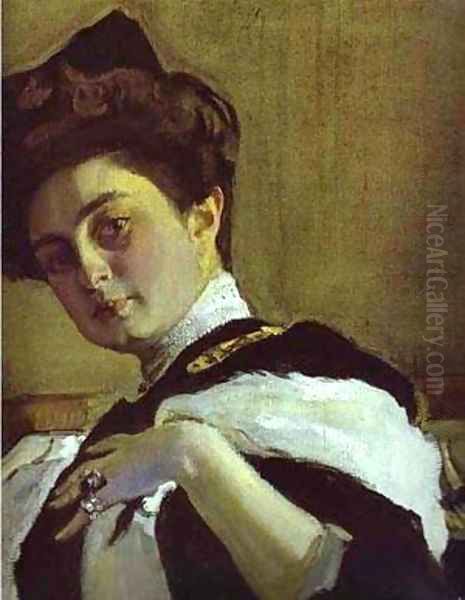
His commitment to artistic integrity was absolute. This was dramatically demonstrated in 1905 following the "Bloody Sunday" massacre, when Tsarist troops fired on peaceful demonstrators in St. Petersburg. In protest against this brutality and the subsequent government repression, Serov resigned from his position as a full member of the St. Petersburg Academy of Arts (he had been elected in 1903, concurrently with his Moscow teaching post). This act of conscience underscored his democratic convictions and his belief that art could not remain indifferent to social injustice. His satirical drawings from this period further expressed his critical stance towards the autocracy.
Later Style: Modernist Explorations
In the final decade of his life, Serov's style continued to evolve, absorbing elements of Art Nouveau (known as Style Moderne in Russia) and developing a more monumental and graphically concise approach, particularly in his portraits. While never abandoning his foundation in realism and psychological insight, his later works often feature bolder outlines, flattened perspectives, decorative patterning, and a more stylized treatment of form.
Portraits like Henrietta Girshman (1907) exhibit a sophisticated elegance and decorative flair. His famous nude portrait of the dancer Ida Rubinstein (1910), rendered with elongated lines and a cool palette, possesses an almost archaic, yet strikingly modern, sensibility. The aforementioned Portrait of Princess Olga Orlova (1911), one of his last major works, combines imposing scale and aristocratic grandeur with a remarkable simplification of form and a focus on silhouette.
His travels, including a trip to Greece with Léon Bakst in 1907, also informed his later work, leading to explorations of classical themes, such as his dynamic composition The Rape of Europa (1910). This late phase demonstrated Serov's continued artistic curiosity and his ability to integrate contemporary stylistic trends while retaining his unique artistic signature. He remained a keen observer, but his means of expression became increasingly bold and summary.
Personal Life and Character
Accounts from contemporaries paint a picture of Serov as a man of integrity, reserved but capable of sharp wit and humor, especially in his youth within the lively Mamontov circle, where he was known to participate enthusiastically in amateur theatricals. He was deeply devoted to his wife, Olga Fyodorovna Trubnikova, whom he married in 1889, and their children. While some sources mention periods of ill health or potential depression, particularly related to the stresses of his demanding work schedule and perhaps the political climate, he remained intensely productive until his sudden death from heart failure (angina pectoris) in Moscow in 1911, at the age of just 46. An anecdote mentions him keeping a pet parrot, suggesting an affection for animals alongside his intense focus on human subjects.
Enduring Significance: A Bridge Across Eras
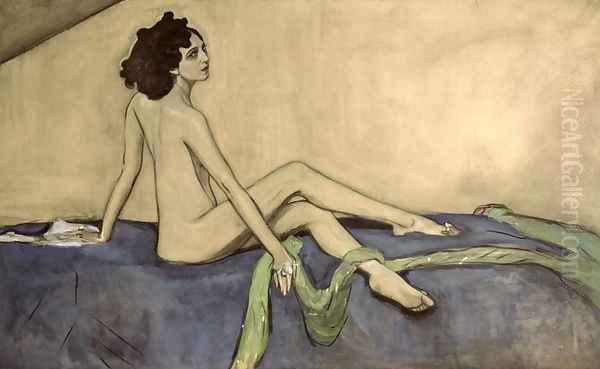
Valentin Serov's death cut short a career that was still evolving, yet he left behind a legacy of immense importance. He is universally regarded as one of the giants of Russian art. His primary contribution lies in his revitalization of portraiture, infusing it with profound psychological depth and adapting it to the changing social and artistic landscape of his time. His ability to capture the essence of an individual, whether a Tsar, an artist, or a child, remains unparalleled in Russian art.
Stylistically, he occupies a crucial position as a bridge figure. Rooted in the 19th-century realist tradition of Repin and the Peredvizhniki, he embraced the innovations of Impressionism regarding light and color, and later engaged with the decorative and linear qualities of Art Nouveau and Symbolism, paving the way for 20th-century modernism in Russia. He demonstrated that realism could be combined with modern aesthetic concerns, creating works that were both truthful and artistically innovative.
His influence extended through his teaching and his participation in key artistic movements like Mir Iskusstva, which played a vital role in broadening the horizons of Russian art and integrating it more fully into the European cultural scene. His mastery across multiple genres – portraiture, landscape, historical painting, graphic art, and stage design – showcases his remarkable versatility. Today, his works are highlights of major collections, particularly the State Tretyakov Gallery in Moscow and the State Russian Museum in St. Petersburg, where they continue to captivate viewers with their technical brilliance, emotional resonance, and timeless insight into the human condition. Valentin Serov remains a testament to the power of observation, the importance of artistic integrity, and the enduring vitality of the Russian artistic spirit.